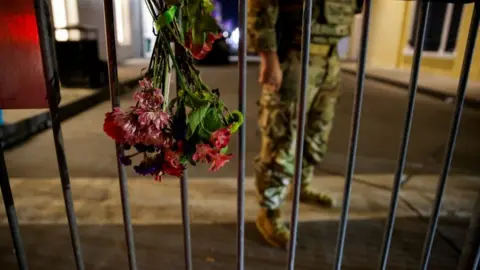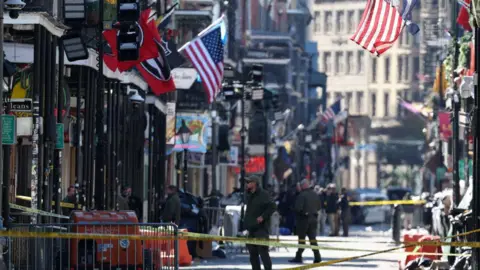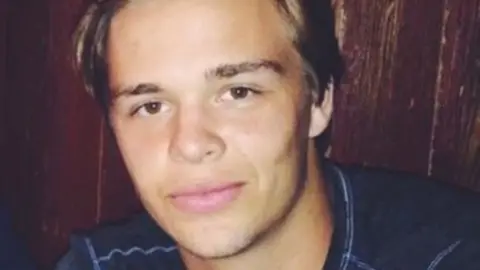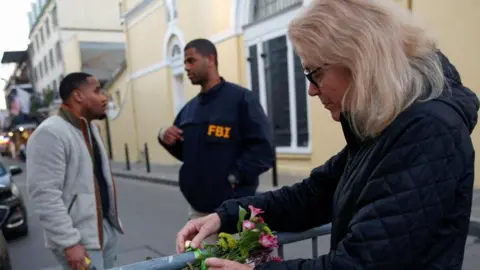New Orleans was in full swing in the early morning hours of New Year’s Day.
Revellers were spilling out of bustling bars and packed clubs in the city’s French Quarter – an area often referred to as the beating heart of the city’s famous nightlife.
“It was all young kids out. Lots of 19, 20, 21-year-olds,” recalled Derrick Albert, a local DJ who plies his trade each night at the corner of Canal and Bourbon streets.
That intersection is home to a packed tourist hotel, a store selling ice cream and chocolate fudge and restaurants selling oysters and daiquiris in large plastic to-go cups.
But at about 03:15 (09:15 GMT), the youthful revelry turned to terror as a man – identified as Shamsud-Din Jabbar, a 42-year-old Texas resident and US Army veteran – drove a rental truck at high-speed into a crowd.
He killed at least 15 people and wounded dozens, some seriously.
Grainy CCTV footage shows the moment the attack began, with the white pick-up truck driving up Canal Street past other vehicles, before taking a right on to Bourbon Street, swerving around a police car, speeding up suddenly and ploughing into the crowds.
“We just heard this squeal, the rev of an engine and a huge, loud impact,” Kimberly Stricklen, a visitor to New Orleans, told Reuters. “Then, the people, screaming. The sound of crunching metal and bodies.”
The vehicle would continue for three blocks – striking more bystanders along the way – until the driver crashed and came to a stop near the corner of Bourbon and Conti streets.
Jabbar then left his vehicle and shot at police. He was killed by their return fire.

“We heard shots, and saw people running past the window,” said Steve Hyde, a British visitor who was at a bar called the Erin Rose, on Conti Street just off Bourbon. “Then the sirens started… I’m heartbroken. I love this city.”
By 03:17 – just two minutes after the attack – New Orleans Police Department officers, already out in force for new year’s eve, were on the scene and calling for urgent help captured in chaotic radio chatter.
“I have at least six casualties. I have an office doing chest compressions on one. I have another white male that’s got agonal breathing,” one officer can be heard saying, referring to a gasping, irregular breathing pattern common in emergencies. “Multiple casualties.”
Soon after, the area was teeming with police, who cordoned off the entire area with crime scene tape and dozens of officers and vehicles as investigators arrived and ambulances drove off.
For Mr Albert, the incident was a close call.
Just a few weeks ago, he’d been issued a ticket by the city and told he had to move down the block from his usual spot – which would have been on the very pavement that the suspect drove through to get past the police car.
“That’s usually my corner,” he told the BBC, gesturing at a Walgreen’s pharmacy at the edge of the crime scene.
“I would have been killed. I got more than lucky yesterday. He’d have run right over me. That ticket saved my life. I’d have been the first one he hit.”

The FBI has said the black flag of the Islamic State group was found inside the vehicle which ploughed into partygoers, along with two suspected improvised explosive devices discovered nearby.
The investigation is ongoing and it remains unclear whether Jabbar acted alone or was part of a larger plot.
But on the streets of New Orleans, much of the debate has focused on whether more could have been done to prevent the attack and keep people safe.
The barriers put in place years ago to prevent vehicles from entering Bourbon Street were in the process of being replaced so there were gaps. A solitary police car was parked there.
“We did have a car there. We had barriers there. We had officers there, and they still got around,” New Orleans Police Superintendent Anne Kirkpatrick told reporters. “We indeed had a plan, but the terrorist defeated it.”
A perceived failure to properly secure the road has left some, like Mr Albert, puzzled.
He believes that the number of people out for New Year’s Eve, as well as the thousands of people in town for the highly anticipated Sugar Bowl American football game that had been scheduled for 1 January, warranted tighter security.

A 2017 memo seen by CBS, the BBC’s US partner, revealed that officials in New Orleans were aware of the risk of a mass casualty attack using vehicles as weapons.
The document specifically referenced similar attacks that have taken place in France, the UK and New York.
“We all knew it could happen at some point. Maybe at Mardi Gras. Maybe the Superbowl,” Mr Albert said. “Of course they could have stopped it… they’ll get sued over that.”

Nearly 24 hours after the attack took place, the corner of Canal and Bourbon streets remained an active crime zone, with dozens of police cars blocking the road and police tape still strung up.
But nearby, life – and the party – slowly began to return to the French Quarter.
Bars on the same block as the attack were doing brisk business, primarily to legions of football fans in town for the rescheduled Sugar Bowl between Georgia and Notre Dame.
Music from a live jazz musician blared over curious onlookers who had come to see the crime scene. Across the street, a Michael Jackson impersonator moonwalked on the pavement as a coroner’s vehicle left the area.
While the area is still reeling from the attack and loss of life, many, like Mr Albert, said they were confident the area will return to normal sooner than later.
“Of course we will,” he said. “Of course we’ll bounce back.”









